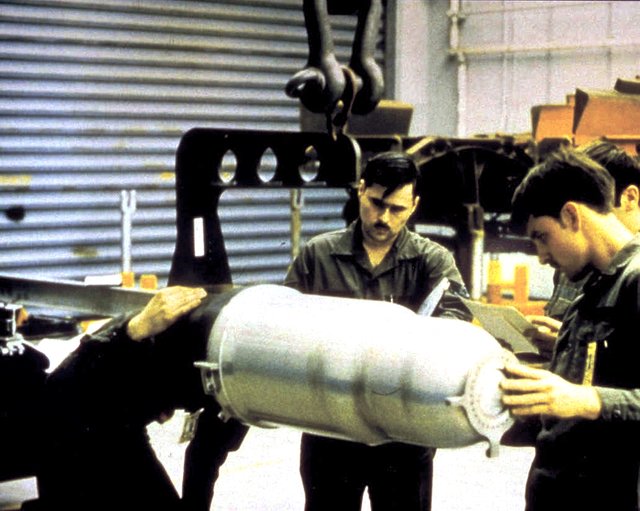
U.S. technicians working with a W80 thermonuclear warhead. Public domain.
On June 16, US president Joe Biden and Russian president Vladimir Putin issued a Joint Statement on Strategic Stability, in which they "reaffirm the principle that a nuclear war cannot be won and must never be fought" and "seek to lay the groundwork for future arms control and risk reduction measures."
With the extension of the New START treaty and joint statements like that, it might seem that things aren't looking too terribly bad with respect to reducing the threat of nuclear war. But talk and action are two very different things. Let's roll back the calendar to the day before the rose-colored glasses went on.
"Despite calls from some Democrats and arms control advocates to slash spending on strategic forces," National Defense magazine reported on June 15, "the Biden administration appears committed to forging ahead with previous administrations' nuclear modernization programs."
The Congressional Budget Office expects the US government to spend $634 billion on operating and "modernizing" its nuclear arsenal over the next ten years, and the Biden administration has requested $43.2 billion for such activities in its budget proposal for next year.
That doesn't sound much like "groundwork for future arms control and risk reduction measures" to me.
And what good are future arms control measures when the parties obviously haven't bothered to fulfill their obligations under past such measures?
Per the Treaty on the Non-Proliferation of Nuclear Weapons, both the US and Russian regimes have been committed for more than 50 years "to pursue negotiations in good faith on effective measures relating to cessation of the nuclear arms race at an early date and to nuclear disarmament."
But according to the Federation of American Scientists' "Status of World Nuclear Forces" report, Russia and the US still maintain arsenals of, respectively, 6,257 and 5,550 nuclear warheads.
And, FAS says, "[t]he pace of reduction has slowed significantly compared with the 1990s and appears to continue only because of dismantlement of retired weapons; the military stockpiles (operational nuclear weapons) are increasing again."
How many warheads constitute a "nuclear deterrent," assuming such a thing is truly needed until we are clearly approaching the zero nuke mark?
Well, the US only has nine cities with populations in excess of one million. Russia only has 15. The ability to wipe out all those population centers, especially from platforms like submarines that aren't likely to be taken out in a surprise first strike, seems like a heck of a deterrent to starting a nuclear fight (and an implicit terrorist threat, but one we're already living with and then some).
Even adding in key military bases as targets, how could more than, say, 50 warheads each (less than one percent of current arsenals) be justified as a "deterrent?"
And what's the holdup on getting down to that number?
No additional agreements are necessary. Either side can do it unilaterally, without agreement from the other, and the other side would be left just wasting money on expensive, dangerous, and effectively useless junk.
It's time to grow up and end this silly nuclear penis size contest.